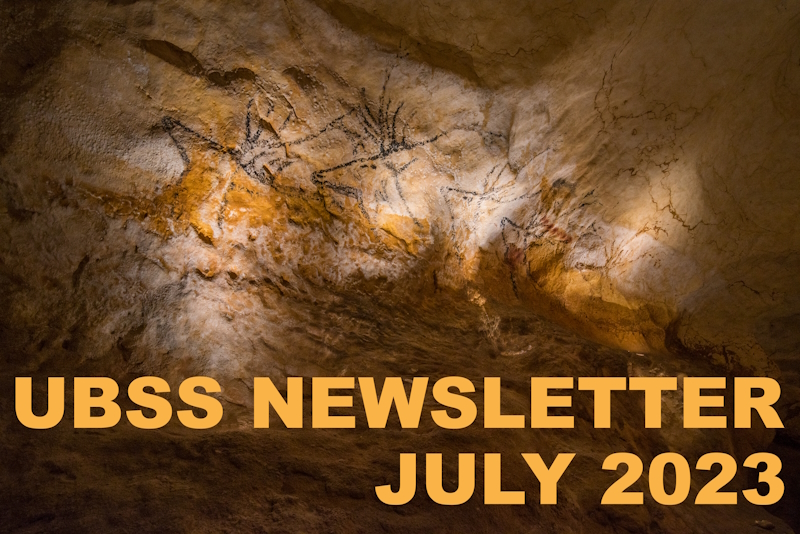
The swimming deer in Lascaux. Official press photo supplied from the opening of Lascaux IV.
|
|
This
summer has been a busy one on the caving front, with some members
joining the Cambridge Austria Expo, one caving in France and another in
Vietnam! And our museum mascot even wangled a trip to the world-famous
painted cave of Lascaux!
As you'll see, Hidden Earth is back and once again, it's near Bristol,
so no excuse not to go. One of the sessions is a workshop on the future
of club newsletters, as some clubs are struggling (as we did) with
producing paper newsletters. One problem being that the news loses any
sense of immediacy and gets harder to gather. But news items generally
don't come up to present themselves, tails wagging, at your beloved
editors' feet. We mostly have to coax, cajole, bribe and nag. To
everyone else's credit, we haven't yet been hit on the head with a brick
and told to stop. So please keep feeding us tidbits, and do let us have
some more memories of times past, as these always seem popular.
We're delighted to have finally embarked on our journey towards the
accreditation of the museum and library with by the Arts Council and
very much hope we'll be able to meet the required standards, but even
if, for reasons outside our control we aren't able to succeed, we will
still have done a huge amount of work and future-proofing of the
management of the collection, and at the moment, we're travelling very
hopefully!
You can find all the back issues of the monthly newsletter online. So if you're relaxing in the sun somewhere, take a look at what the club has been up in past months and years.
With very worm wishes for the remainder of the summer, despite the recent heavy rain!
Linda and Alex
|
|
|
OFFICIALLY AWESOME!
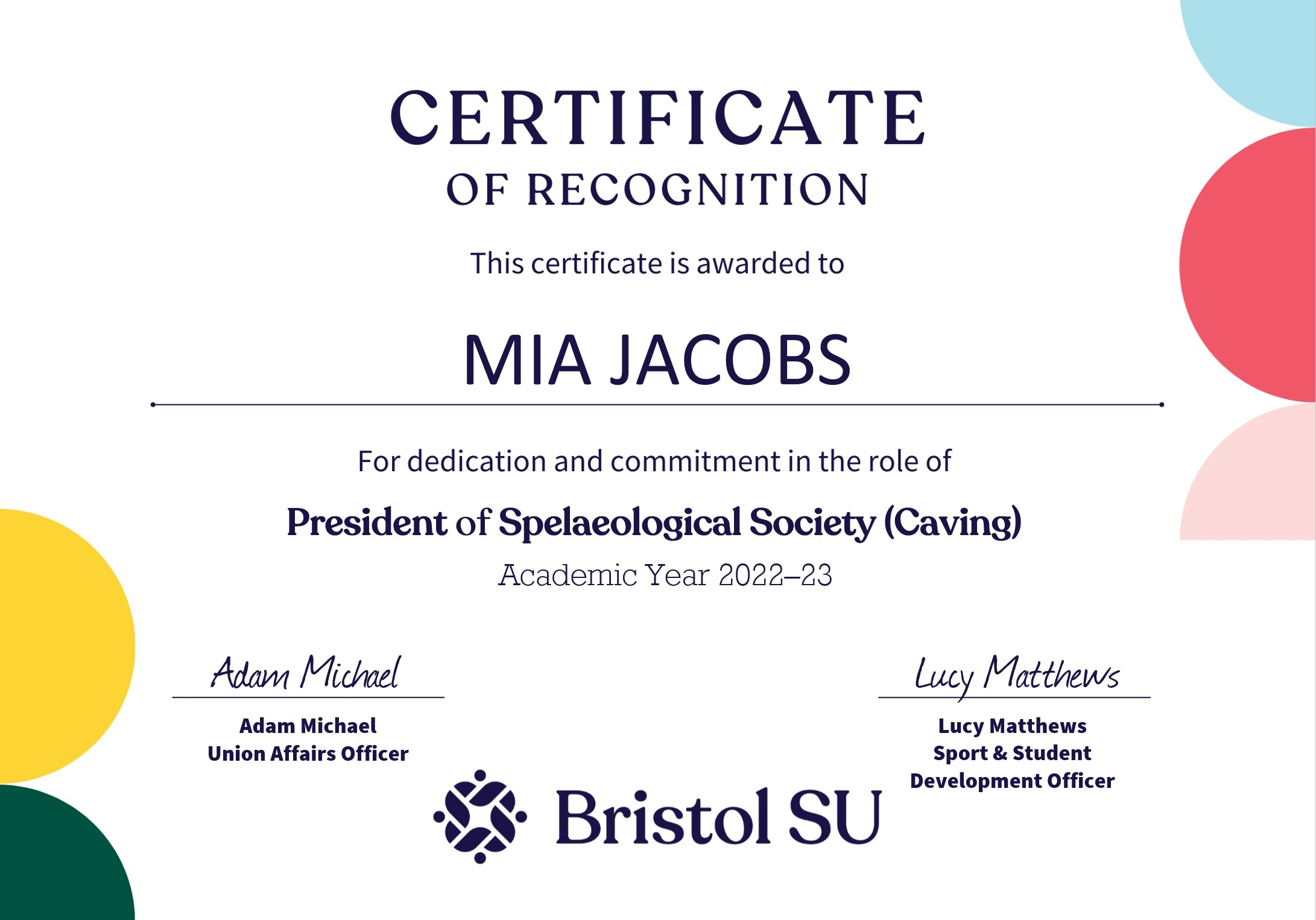
We've always known Chief Worm Mia Jacobs is awesome, but now it's official!
|
|
LET'S GO FISHING!
Fishing for answers image created by Jess Peto.
Are you free on the 19th August 2023?
We're intending to go fishing for some more answers in Fishmonger's
Swallet, Alveston near Bristol on 19th August. We'll be carrying out
another archaeological dig in the cave, so this is an unparalled
opportunity to get very muddy indeed helping to haul buckets of mud and
rocks to the surface and help to wet sieve each one for bone and pot
fragments. Sounds attractive? Of course it is! we're cavers, aren't we?
We like playing in mud.
Fishmonger's is a fascinating cave and not just for the wealth of
archaeological material it's yielded. The last issue of our Proceedings
was dedicated to the site, with the history of exploration and reports
on the human and faunal remains, as well as the geology.
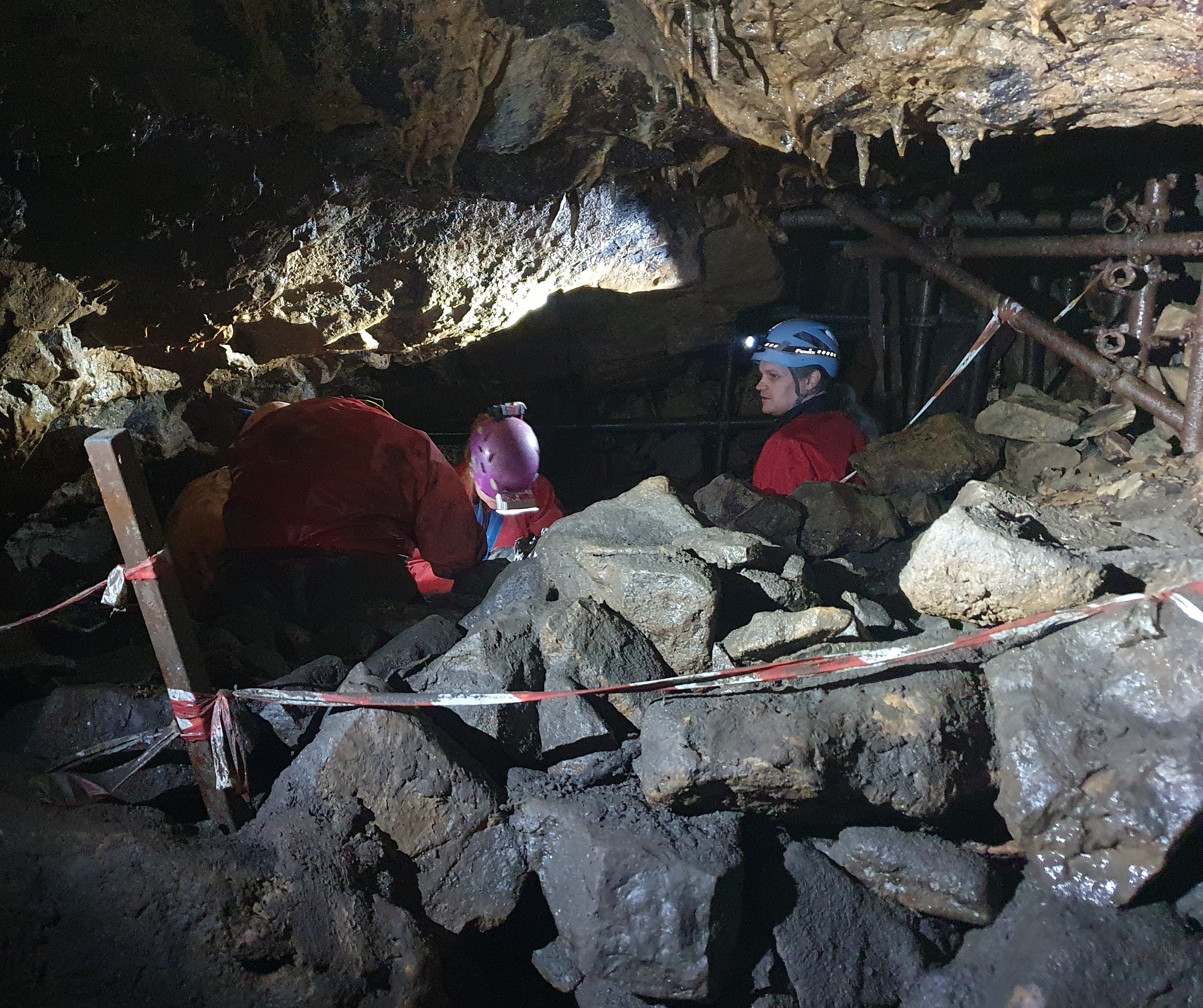
Digging in Bone Idle Chamber. Nathan Cubitt (right), Adelle Bricking (middle). Photo by Linda Wilson.
The human remains have been dated to the
late Iron Age, just prior to the Roman invasion, and the fracture of a
human long bone, characteristic of the splits made for marrow
extraction, have led to an inference of cannibalism, which has proved to
be of enduring media fascination. There were also large numbers of dog
bones, mostly the size of small greyhounds, but some are smaller and
might well represent the smallest known Iron Age dog, dating to around
125 BC. Recent DNA work by our colleagues at the Crick Institute has
shown the dog, known as Harris, to be female and we're waiting to hear
if the genetic material will yield more detailed information such hair
colour. Small dogs were originally thought to have been introduced to
Great Britain by the Romans, but Harris and others have now shown this
view to be incorrect.
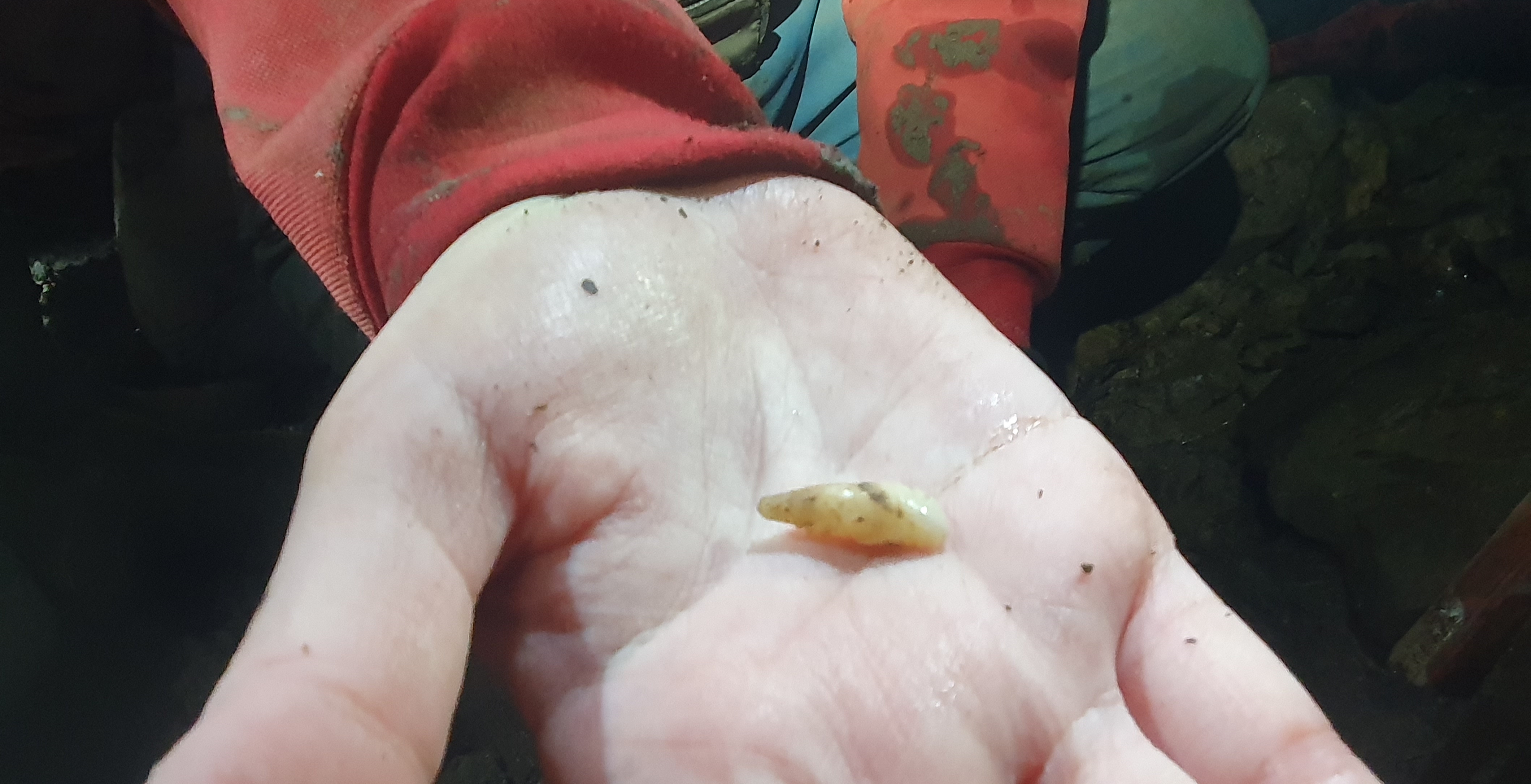
Human tooth found by Dr Adelle Bricking on our last dig.
If you'd like to help us fish for more answers in this amazing site, let me know,
and join us on the dig! I can probably arrange transport if you need
it. The site is only about 15 - 20 minutes north of Bristol. You'll also
get an exclusive Harris sticker as a reward. Can't say fairer than
that, can we?
Linda Wilson
|
|
HIDDEN EARTH IS BACK!
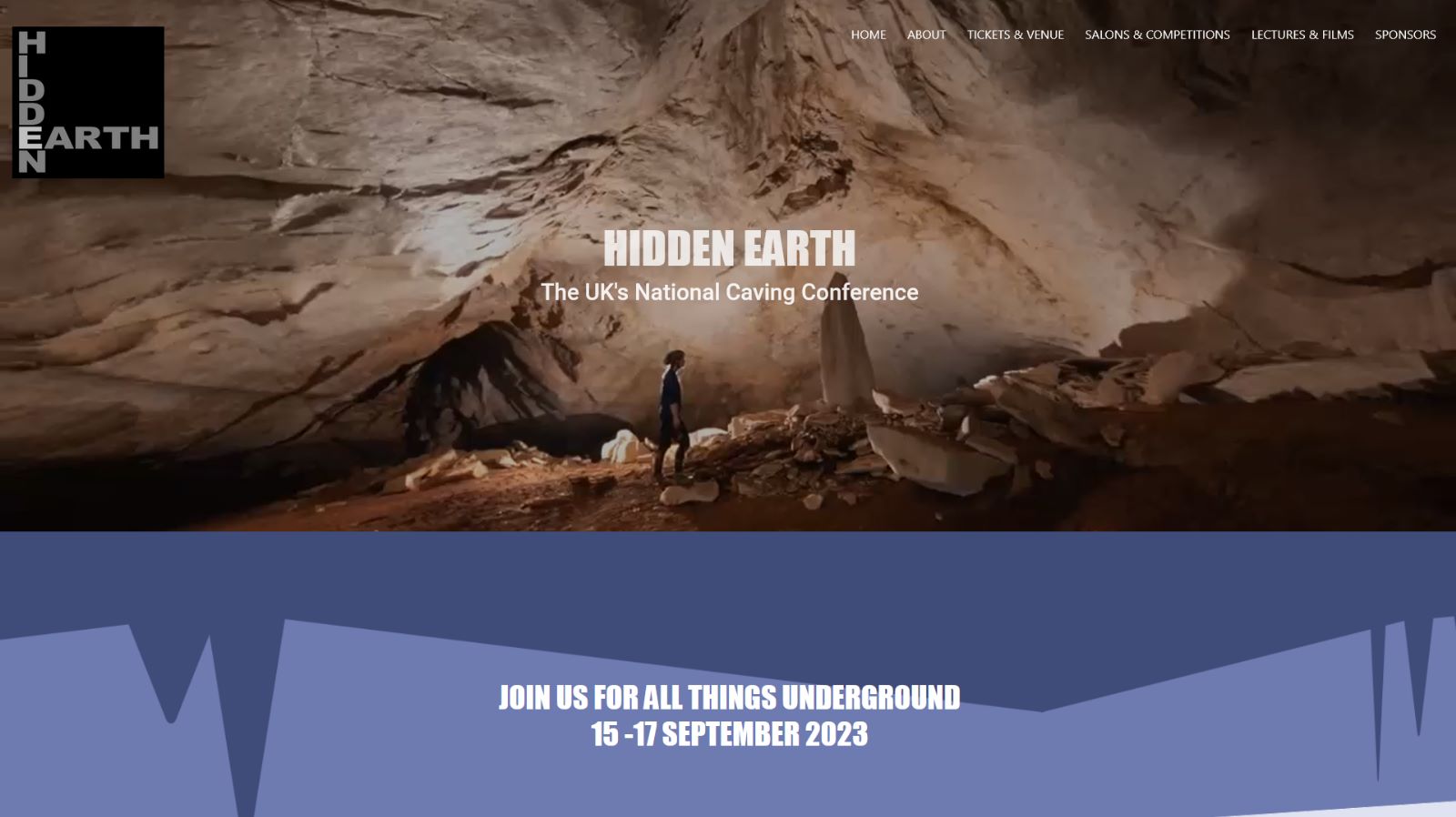
The Plague combined with problems finding a large enough venue
to suit hundreds of boozy cavers has kept Hidden Earth, the UK's largest
caving extravaganza, off the calendar since 2019, but it's finally
back, and it's happening near Bristol!
After much hard work by the organising team, the venue for 2023 has been
confirmed as Gordano School in Portishead, only a short drive from
Bristol. The dates are the 15th - 17th September. There'll be a wide
variety of talks, workshops, competition, club and trade stands, and
plenty of time to meet friends and mingle in the bar.
Tickets are not yet available, but some talks have already been confirmed, with loads more to follow.
Keep an eye on the Hidden Earth website for ticket sales and other information.
We'll be having a UBSS stand so we can sell our books and showcase the club, so do come along to help out!
|
|
LASCAUX COMES TO BRISTOL
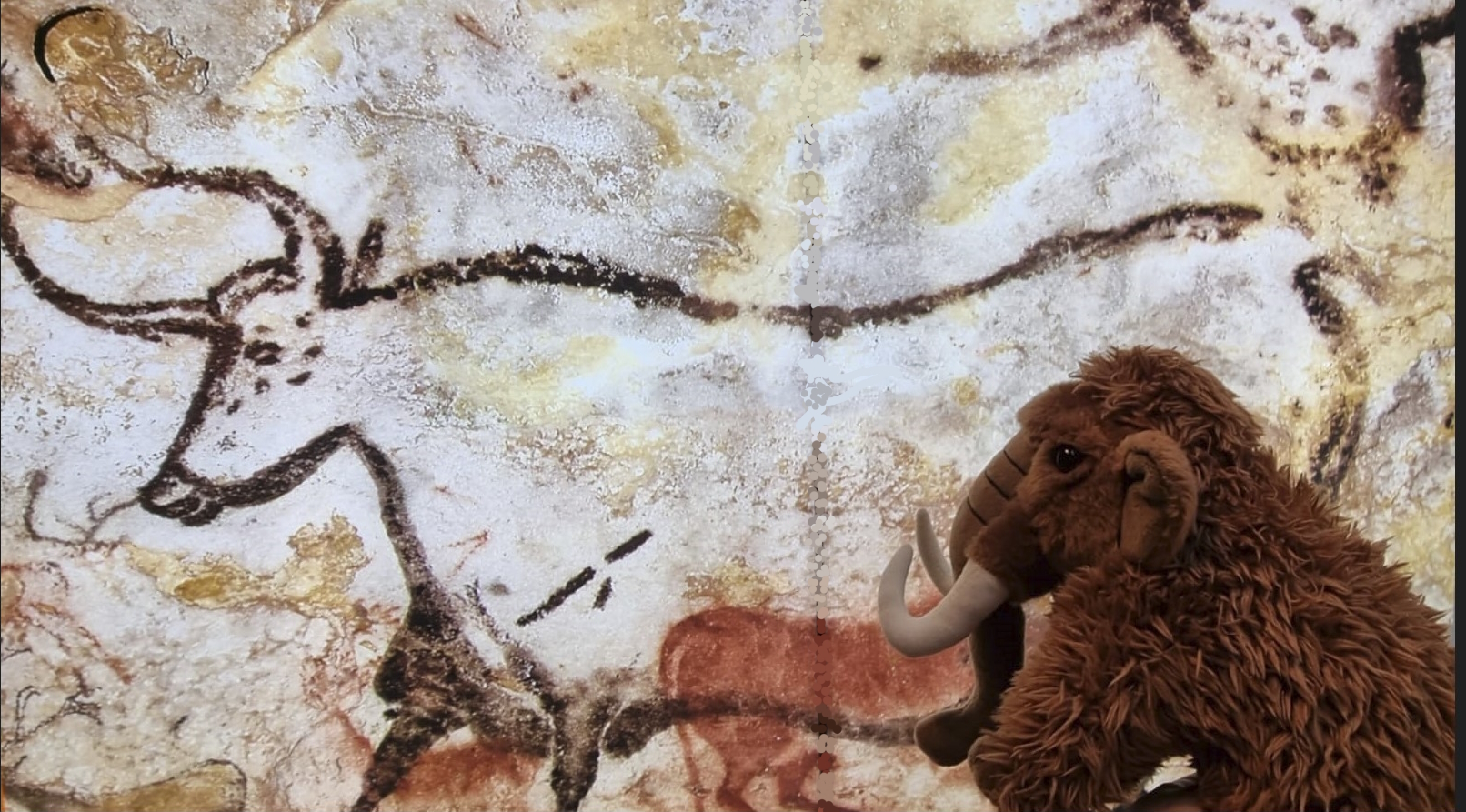
Lascaux III's most famous visitor. Photo by Nathan Cubitt.
Most cavers will have heard of
Lascaux, the amazing Upper Palaeolithic decorated cave located just
outside Montignac in the Dordogne region of France. In April this year, a
new version of the cave came to Bristol in an exhibition that runs
until 10 September. Several UBSS members, including our own museum
mascot Whatley Mammoth have ventured into the virtual reality world of
this famous decorated cave. Here, Graham Mullan gives the background to
the site, Whatley (with his faithful companion, Nathan Cubitt) susses
out the competition and Linda Wilson goes crawling to some French
dignitaries …
Lascaux was discovered in September 1940 by 18-year-old Marcel
Ravidat when his dog, Robot, investigated a hole left by an uprooted
tree. On exploring the cave, Ravidat and his friends discovered a wealth
of paintings and engravings covering the walls and ceiling. These are
considered to be early Magdalénien in age, that is they are around
21,000 years old.
The cave was opened to the public in July 1948 but by the mid-50s CO2,
humidity and other contaminants produced by around 1,200 daily visitors
were visibly amaging the art and eventually, in 1963 the cave was
closed to the public.
In 1983, Lascaux II was opened. This is an excellent replica of the
cave’s Great Hall of the Bulls and the Painted Gallery, located on the
hillside just 200m from the original cave. This attracted many thousands
of visitors annually and used to be France’s largest visitor attraction
after the palace of Versailles.
In time, concerns grew that the proximity
of Lascaux II to the original and the traffic that it generated to the
hillside was becoming part of the environmental threat, not just to the
original cave but even to the replica and a decision was taken by the
French government to build a new, larger replica of the cave at the foot
of the hill and to turn the hillside into a reserve with only a few
visitors and no traffic. This new replica, Lascaux IV, was opened on
December 10th 2016 by President Hollande. An account of how Linda and I consumed our body-weight in foie gras at opening of the new site can be found here.
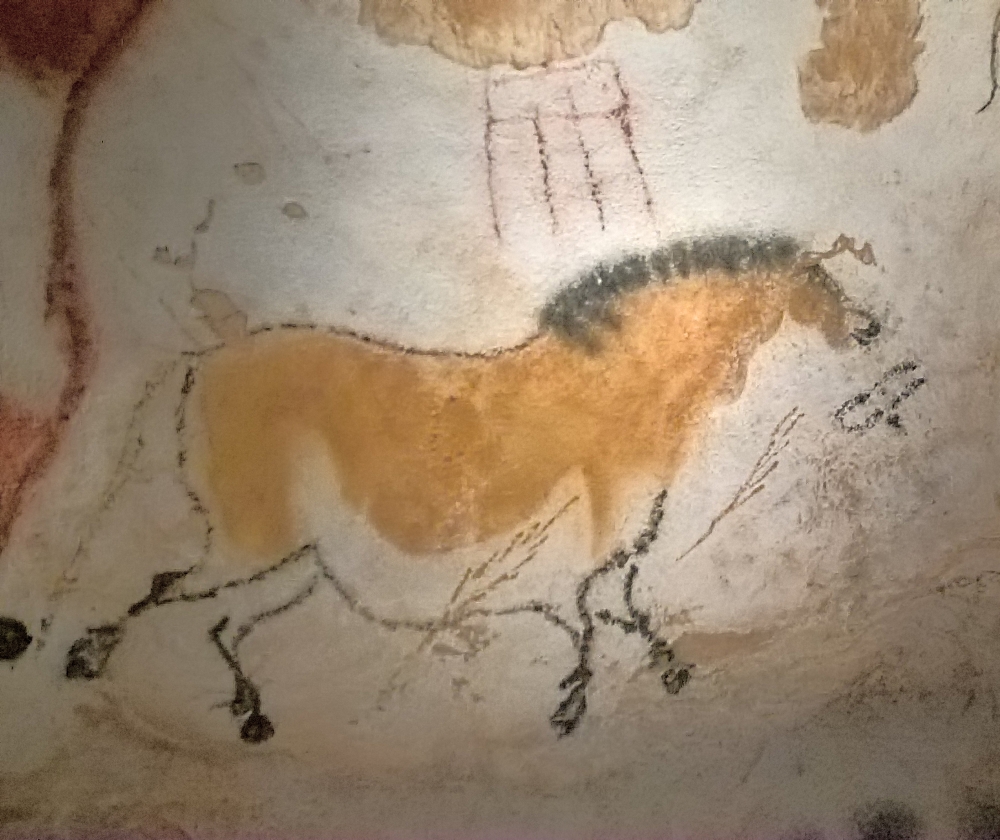
Painted horse. Photo taken at the opening of Lascaux IV by Linda Wilson.
So, that’s Lascaux I, II and IV. So what’s
Lascaux III? This is an exhibition that has been travelling around the
world since 2012. It includes replicas of the Shaft and the Nave as well
as a wealth of associated archaeological, anthropological and
ethnological material. However, there is now another travelling
exhibition which might be called Lascaux IIIB.
Lascaux IIIB is a virtual reality tour of the cave, based on the scans
that were carried out in the making of Lascaux IV. Due to an
availability in its schedule, the exhibition was snapped up by Bristol
City Museum.
Graham Mullan
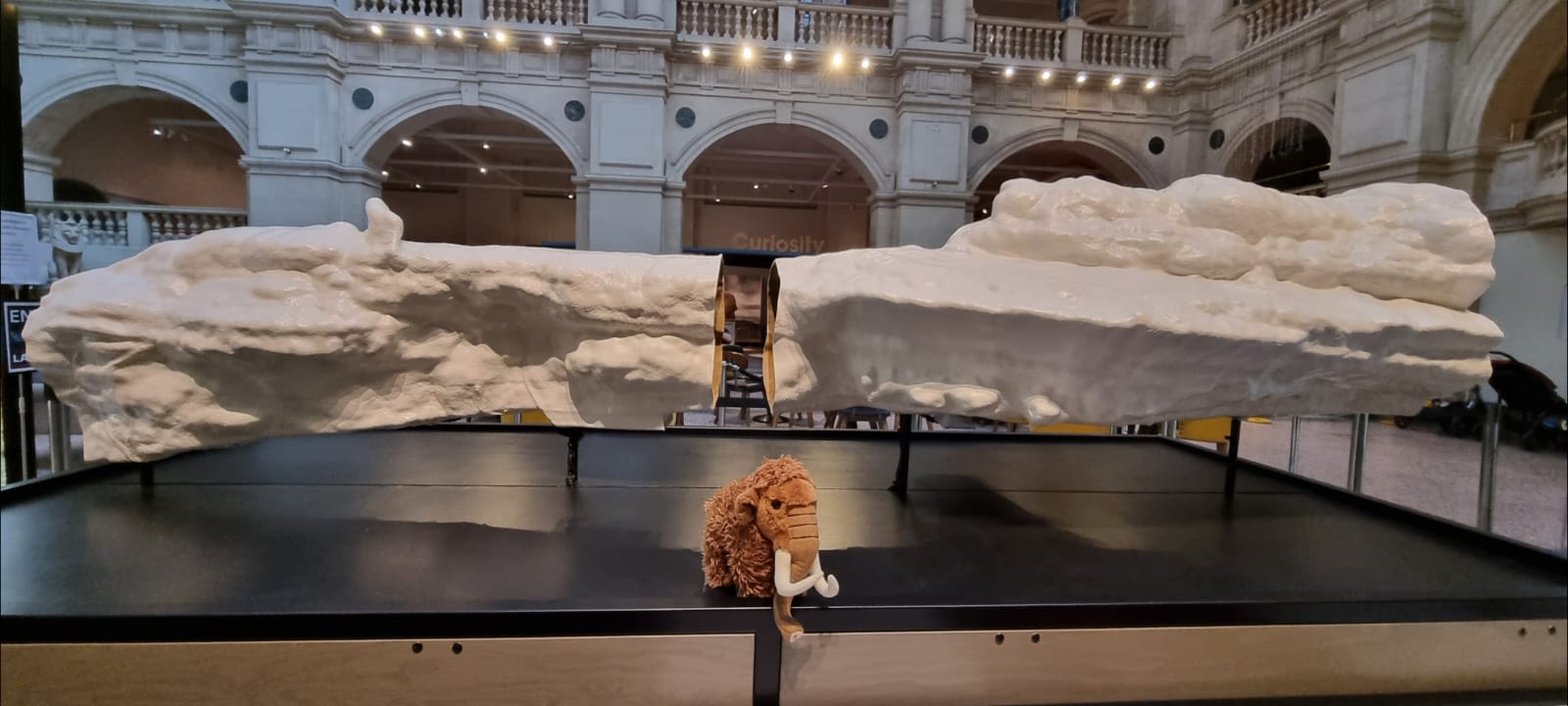
Whatley Mammoth in front of one of the models in Bristol City Museum. Photo by Nathan Cubitt.
Hmm, goodness, gracious, great
bulls of fire! What are they doing on my turf? Don’t they know that
Bristol is Mammoth Territory? Naturally this flagrant breach of the
gentlemammoth's agreement about not stepping on each other's toes
warranted a look see before I decided whether a shake down was in order.
So I went down there to take a look.
First off there's an accompanying exhibition, with large displays
covering the discovery and exploration of the Lascaux cave system, along
with various finds recovered from the site. This makes for a good
introduction for those who know little about the incredible story of
Lascaux. Also on display are amazing 3D scale models of Lascaux, which
are a truly wonderful way to display a cave system, allowing you to peer
into cross-sections. The interiors of the models included the cave
paintings on the inside.
The main event, though, is the virtual reality experience. You enter a
darkened room, with areas marked off on the floor for each person who
has signed up for the experience. They are designed to allow you to move
around, but are tied to the VR headset to stop you going too far or
walking into a wall or another person.
After a safety and fitting briefing, in our instance given by a member
of staff who goes caving (we chatted about the Mendips and Browne's
Folly) we were handed our headsets. These are designed to fit any size
head, from mammoth to children and once you’re properly equipped, you
step into your designated area and get ready to go caving.
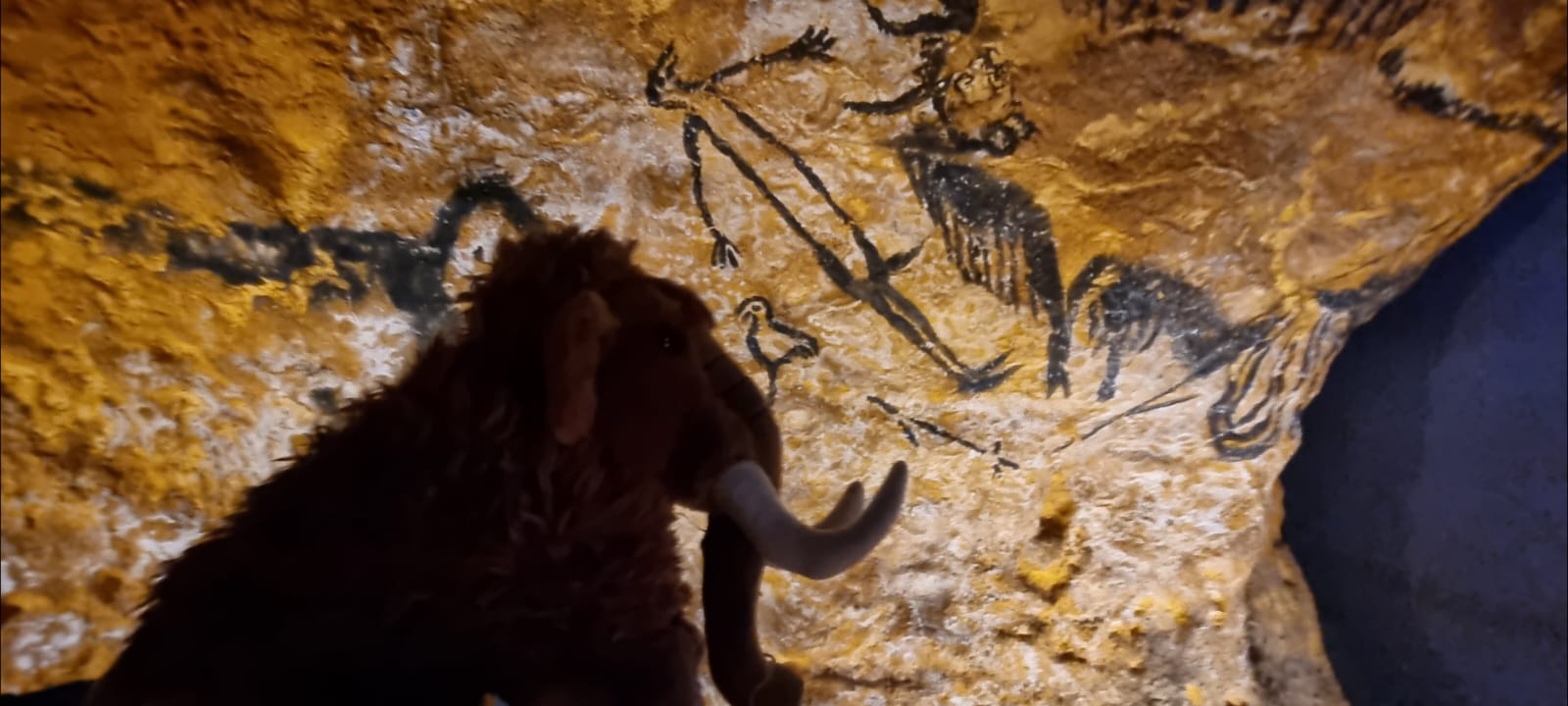
Wot, no mammoths? Whatley inspects the
curious scene in the Pit. A duck on a stick looks the other way after a
man with an erection unwisely picks a fight with a bison.
There's a few introductory things on
navigating the experience, narrated by the voice of God, I mean a Morgan
Freeman sound-a-like, who was our guide throughout the journey.
The VR itself is very smooth. It can be a bit disorientating to
distantly hear God speak to others on the journey, but no more so than
hearing people's voices from other chambers. The narrator guides you
where to look, but you do have free reign within each chamber, although
you can't go too far before hitting the virtual boundaries. The
exploration and narration is very well handled, and VR opens up new
experiences. Those 3D physical models we saw outside? They are in the VR
too, but now you can put your head through the rock and see what's
inside. A lovely touch.
On the whole it is like walking through a museum, until you get to the
final chamber of the display. Now you are placed properly within the
cave, and the floor is exactly as you'd expect, making you wonder how
you are standing up when it slopes! It's hard to explain, but it was
genuinely a close experience to that of actual caving. You could work
out how you'd progress through the chamber and everything, whilst being
fully safe. At any time you could stop and get help from the staff.
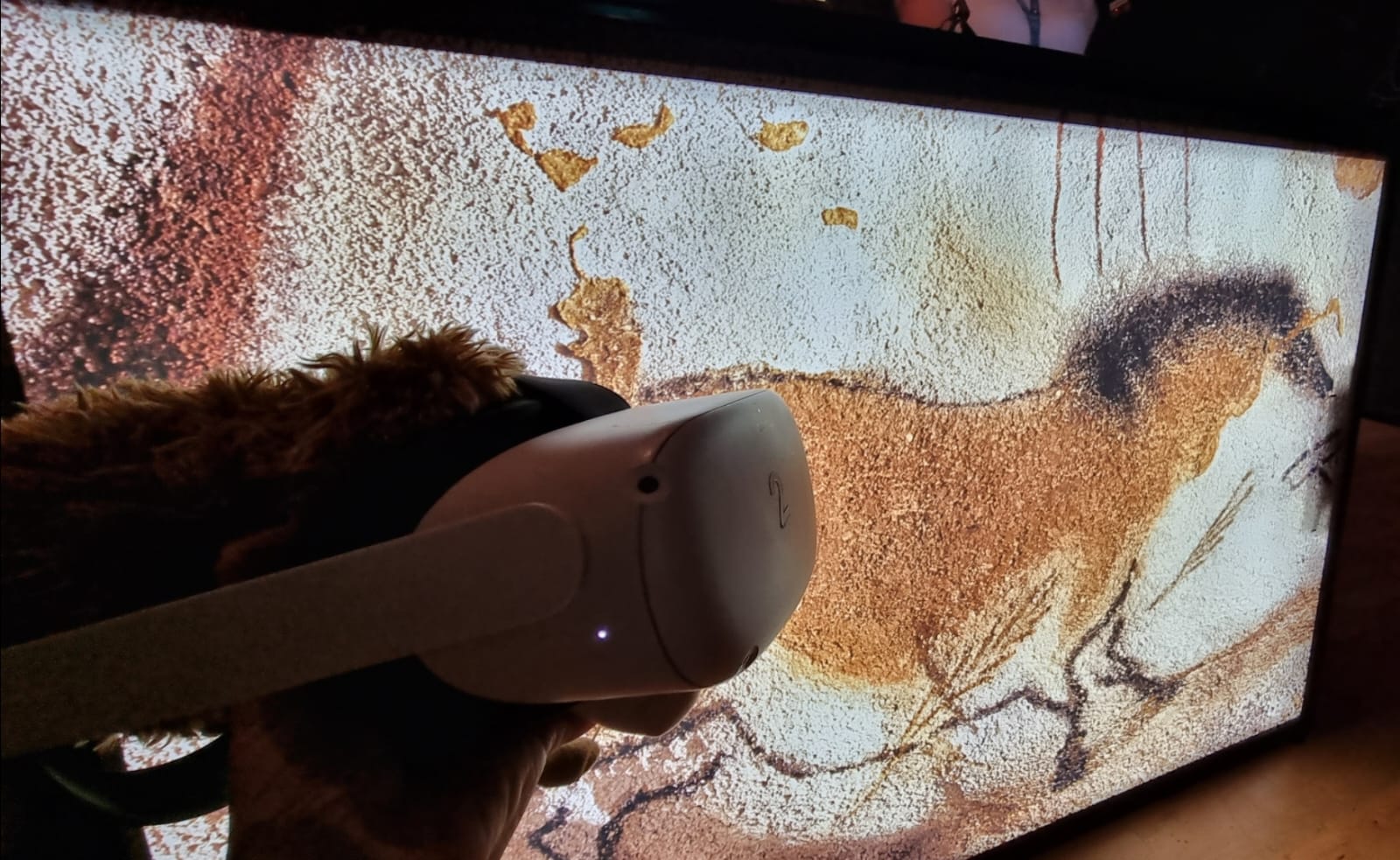
See, told you they had headsets fit for a mammoth!
The VR itself isn't necessarily a long
experience, probably between 15-30 minutes depending on how you pace
yourself, or spotted the experiences you had to complete to progress.
This mammoth was so impressed he won't be taking issue with Bristol
Museum! Our only real gripe would be a lack of mammoth art in the VR
world, which is at odds with what's in the museum shop! (Hint to the
makers of soft toys – more aurochs and reindeer, please!)
VR has come a long way in recent years, and this was brilliant. The
whole experience is highly recommended – and remember there are
concession prices available at a cost of £10 for anyone aged 16–24.
Whatley Mammoth and Nathan Cubitt
I approached the idea of virtual reality with some trepidation,
but having seen the original cave as well as the two physical replicas, I
was determined to have a go at completing my Lascaux bingo card.
However, my previous experience of VR wasn’t too great. In Lascaux 4
there’s a virtual fly through of the Passages of the Felines, a narrow
section at the end of the cave with a vast number of lion engravings,
and I was keen to see this as it’s beyond even the area you get to see
on a rare visit to the original cave.
On that occasion, I donned the headset and was getting on really well,
right up until the moment that I was almost overcome by the urge to
projectile vomit all over the screen in front of me. I ripped the
headset off just in time, but it was a very close run thing, and it was
several minutes before I could safely stagger away. I had a splitting
headache and felt nauseous for the rest of the afternoon. Other VR
experiences followed much the same pattern, so I was pleased when we
were able to visit the exhibition as part of the Museum’s Summer Open
Evening. At least that way, if I threw up, it wouldn’t have cost me 15
quid for the privilege.
Much to my surprise and delight, once I’d got the headset adjusted, I
had no problem, although I remained cautious the whole time. The images
stood out in startling clarity, and the depth of the vision really
helped transport me back into one of the best caving experiences I’ve
ever had, with the aurochs, horses and bison all as clear and colourful
as I remember them. We saw the original cave after a week of heavy rain
in late November, and our guide told us we were lucky as the moisture in
the walls intensifies the colours, and the 3D scan brings out the same
effect.
Our facilitator in the City Museum warned us that at the end, we’re be
invited by our virtual guide to get down on the floor and crawl around,
but that it wasn’t compulsory. I was fully expecting not even to get
that far, but to my surprise, I felt fine, although it was extremely
disorientating to get down on my hands and knees in the real and virtual
walls at the same time. I entered into the spirit of the thing and
crawled around, peering at as much as I could, until I finally finished
all there was to see and took the headset off …
… to find myself staring up at three people from the Museum and their
two guests of honour, the Deputy Conseil Generale for the Dordogne
region and the Director of the travelling exhibition. As Graham and I
were the only visitors at that stage of the evening, it seemed only
polite to express my appreciation in French, which promptly thrust me
into a conversation with the two dignitaries, neither of whom spoke much
English, who were accompanied by a member of the museum staff who spoke
less French than me. On discovering that we have a house in the area
and had visited the original cave, they happily chatted away for a
while, until the official part of the evening started and we even got an
impromptu name check in one of the speeches. It was a lovely evening,
made all the better for the lack of projectile vomiting on my part!
Linda Wilson
Tickets for the VR tour can be booked online.
|
|
CCC LTD PERMITS GO PAPERLESS
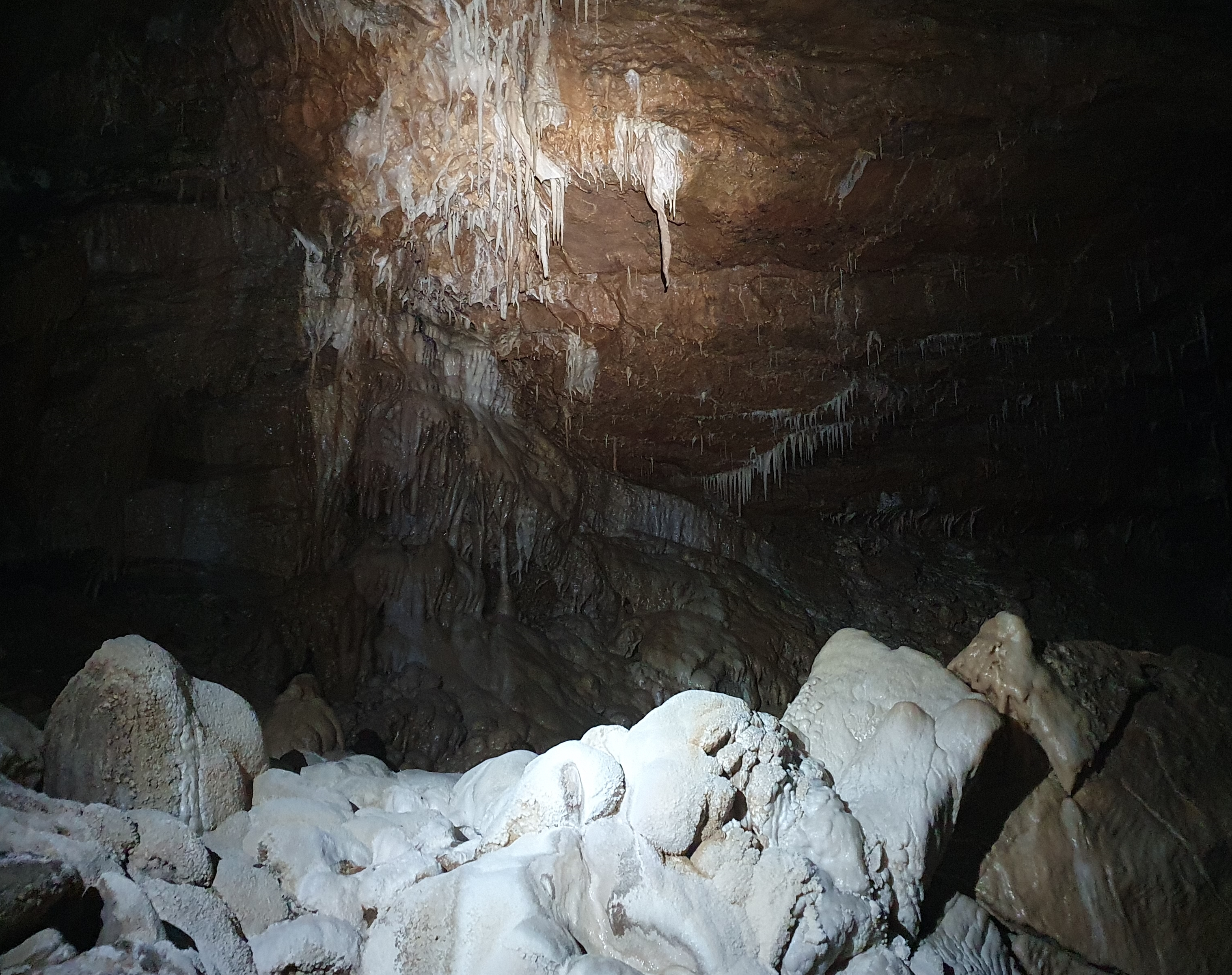
White Passage, GB Cave. Photo by Linda Wilson.
Since the Dawn of Time (the early
1950s), access to caves in the Charterhouse area of Mendip, including GB
Cave and Longwood Swallet, has been managed by cavers for cavers on
behalf of successive landowners.
This long and occasionally tedious work is carried out by the
Charterhouse Caving Company Ltd (CCC Ltd) for Somerset Wildlife Trust
(SWT). As a condition of access ,each visitor to the land/caves must
hold a permit acknowledging that they've read and agree to comply with
the regulations. These permits are currently issued as slips of paper,
familiar to most cavers who visit Mendip.
However, to save trees, bureaucratic hassle, and cavers' pocket money,
CCC Ltd is introducing a paperless system! Once the new system is up and
running – the target date is 1st September – cavers will be able to obtain their permits online ✨for free✨ directly from the CCC Ltd website.
Permits will be downloadable to be saved to your phone (or printed out,
if you prefer). These must be shown by all members of the party when the
key is collected. Paper permits will no longer be available from caving
clubs once the new system goes live.
So don’t forget yours when you want to visit the caves!
Charterhouse Caving Company Ltd
|
|
2023 EXPO!
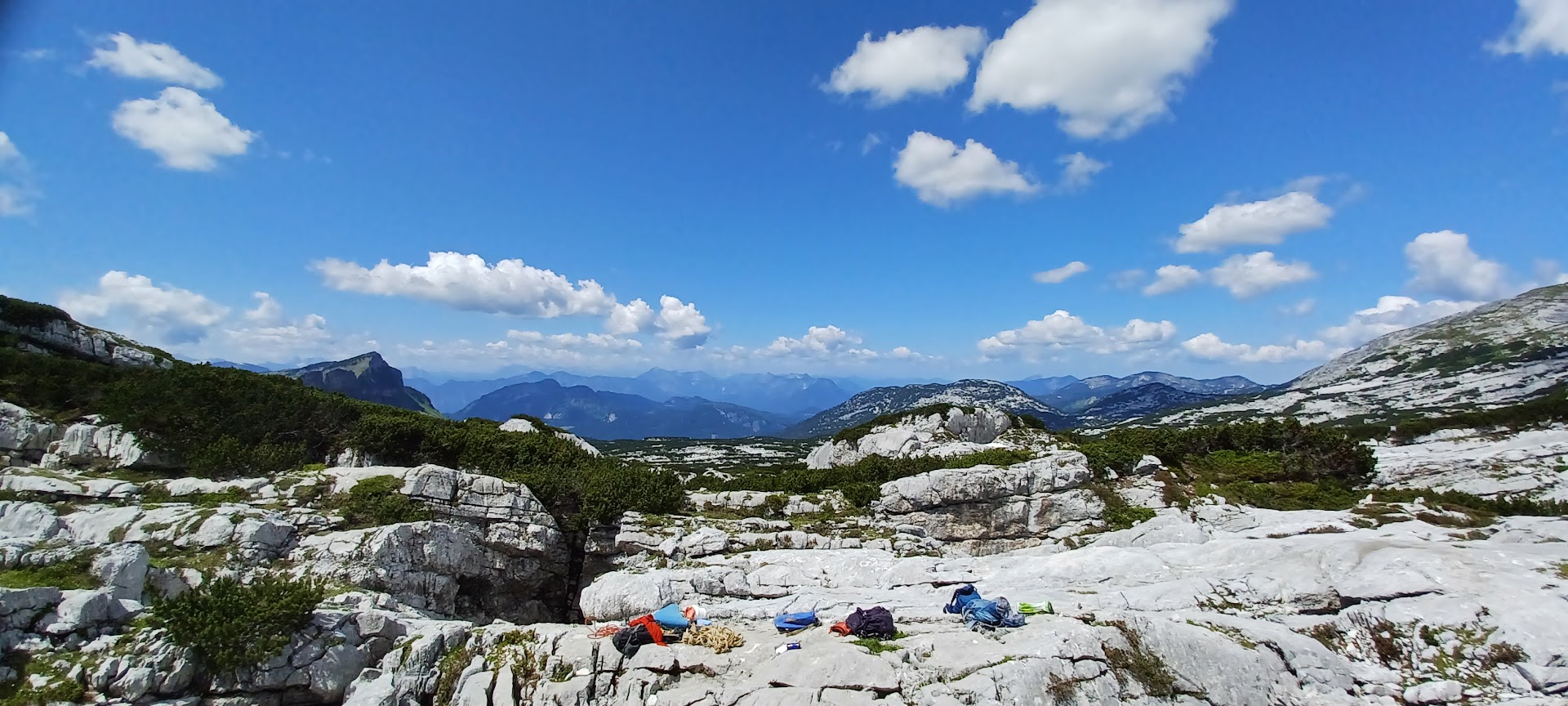
The UBSS has a long history of involvement with the CUCC
Austria trips. This summer was no exception. Zac Woodford gives a quick
overview of what went on.
Stories are the threads in the fabric of our society. Wrapped in their
blanket, whether we be alumni or students, old or young, party animals
or exploration fanatics, they are what make us cavers. Many an ear at
the pub has been graced by tales of the fantastical and extreme. But
throughout my entire time at university one source of stories has been
elevated above others: the Cambridge University Caving Club Austria
Expedition.
Tales of huge passageways and volumes chambres, wild parties, and
friendships forged with members of other clubs the country over. Lest to
say it had been a long term aspiration of mine to attend. And while I
can't speak for Merryn I do know that she has wanted to attend for a
long time too.
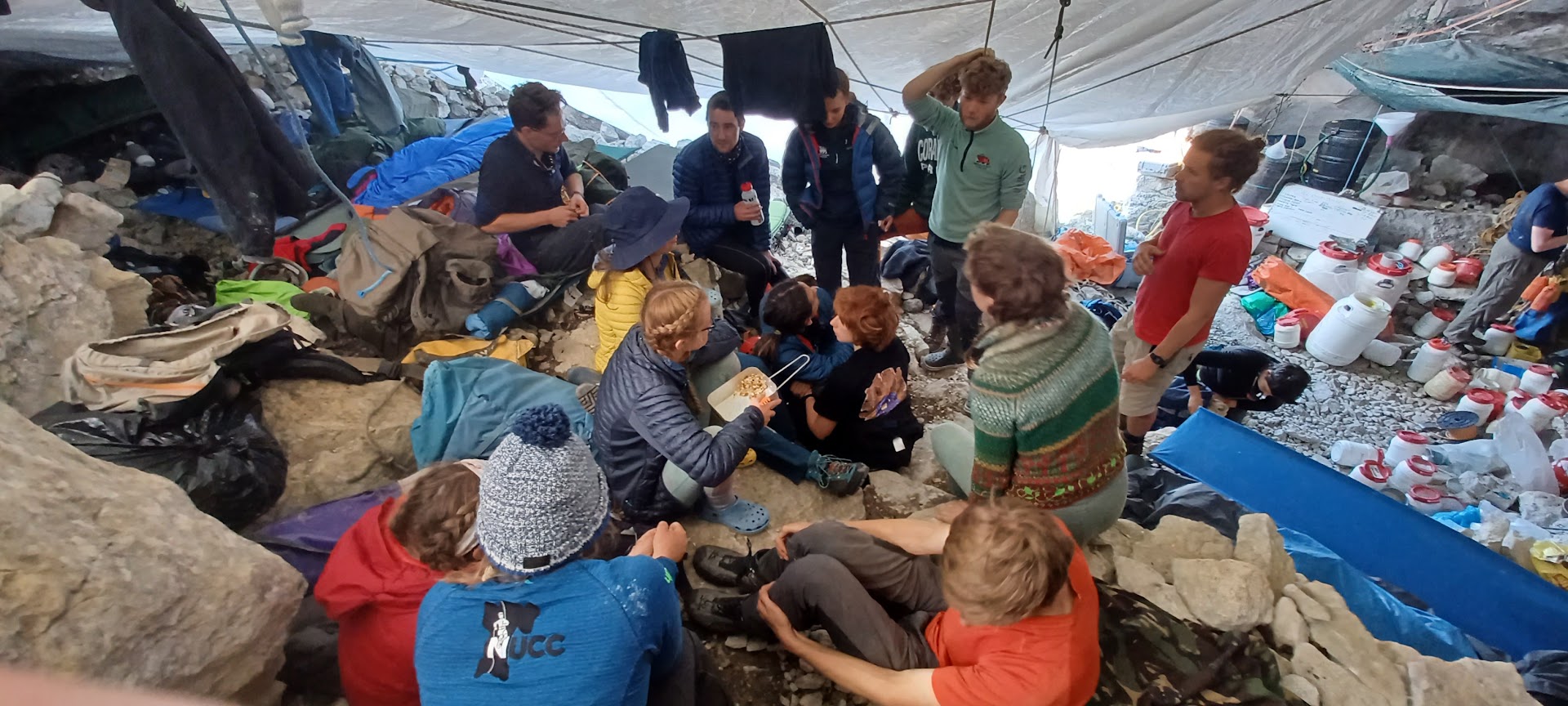
So after months of planning, meetings and, of course, faffing, me,
Merryn and Ash found ourselves in Bad Ausse, Austria. Far too much
happened in the three weeks for me to describe in a single entry but
I'll give you an overview…
Find cave, bolt/rig cave, get Ash in to survey cave, Ash kills cave.
Jokes aside, the UBSS contingent managed to survey a considerable amount
of passage as well as several small surface caves.
There was also plenty of prospecting (finding new cave) as well as other
leisure activities such as swimming, river walking, hiking, canyoning
and more (all that between operating the 24/7 chip factory)!.
Overall, I was slightly disappointed with the amount of caving I got
done (three times in as many weeks), but that’s not to say I didn’t have
a good time! If anything it has made me more excited for next year's
expo. There is still plenty of cave left to discover!
We’re very grateful to the University of Bristol’s Tratman Fund for supporting the three of us on the Expo.
Zac Woodford
|
|
MUSEUM NEWS
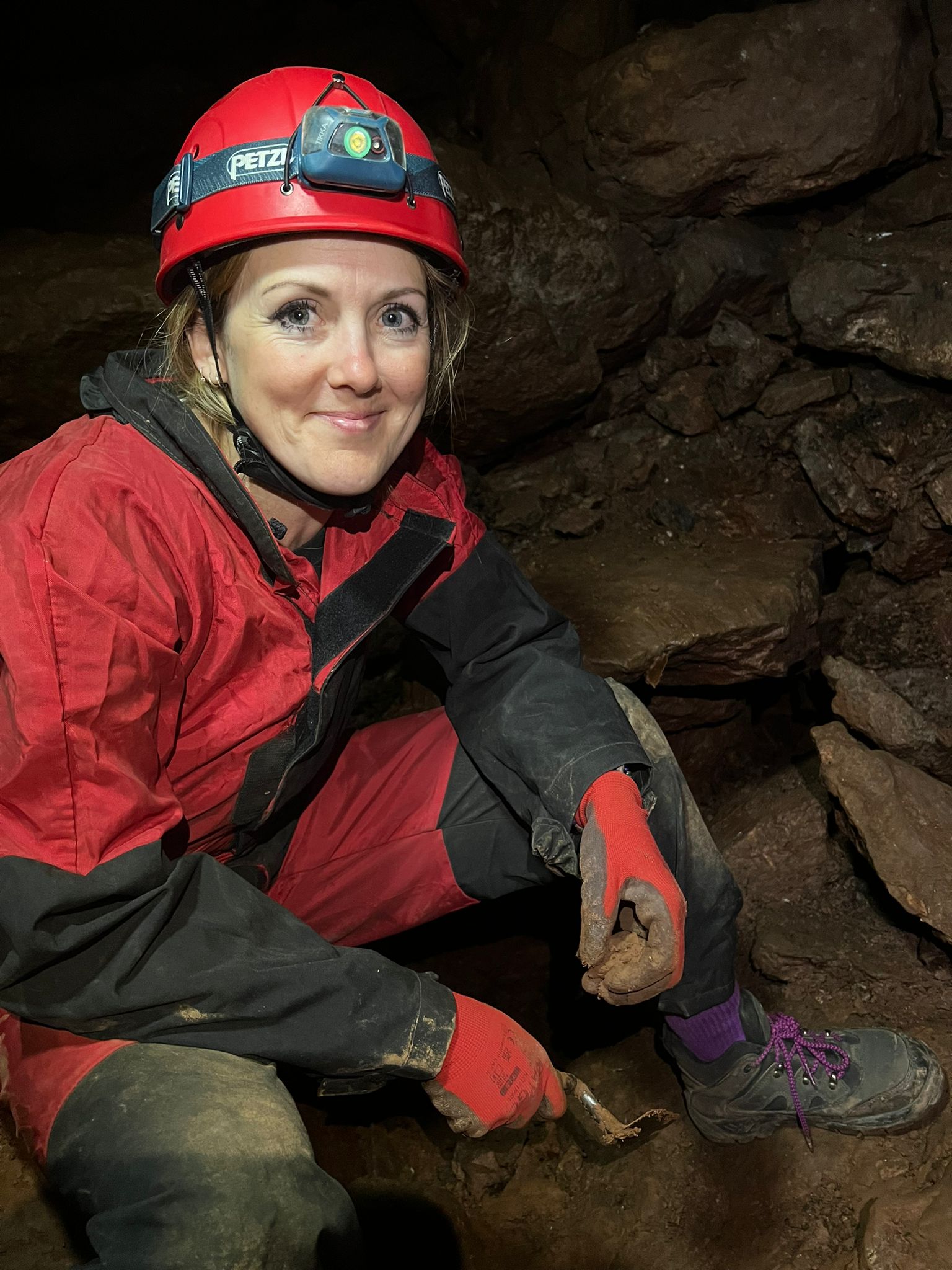
Charlotte Harman digging in Read's Cavern. Photo by Kostas Trimmis.
In exciting news, our museum
intern, Charlotte Harman, has started work on our long-held aspiration
to take the museum and library to accreditation by the Arts Council. The
project is being financed by the Oliver Lloyd Memorial Fund. Charlotte
is also working on the re-display of our collections following the
recently completed building works on the Stables. We asked the latest
member of our museum team to introduce herself ...
Hello, I am Charlotte the student intern who is working with Linda to
enable museum accreditation and then to re-display the society
collections in the newly refurbished space.
I am relatively new to caving having previously only done the Wookey
Hole experience (loved the abseiling element) and then visiting places
like Dan yr Ogof in Wales, Cheddar Gorge, the grottoes on Capri –
the usual walk-in tourist destination sort of caves. This changed in
June when I was able to take part in the Read's Cavern dig (see last
newsletter) and then spend a week excavating in a cave in Croatia (more
on that to come in a future issue). I have loved the experiences and am
very much looking forward to joining UBSS in Fishmonger's Swallet in
August.
I was part of the Bristol Scholars scheme, have just completed my
undergraduate degree in Archaeology and Anthropology and will be
graduating this month with first class honours.
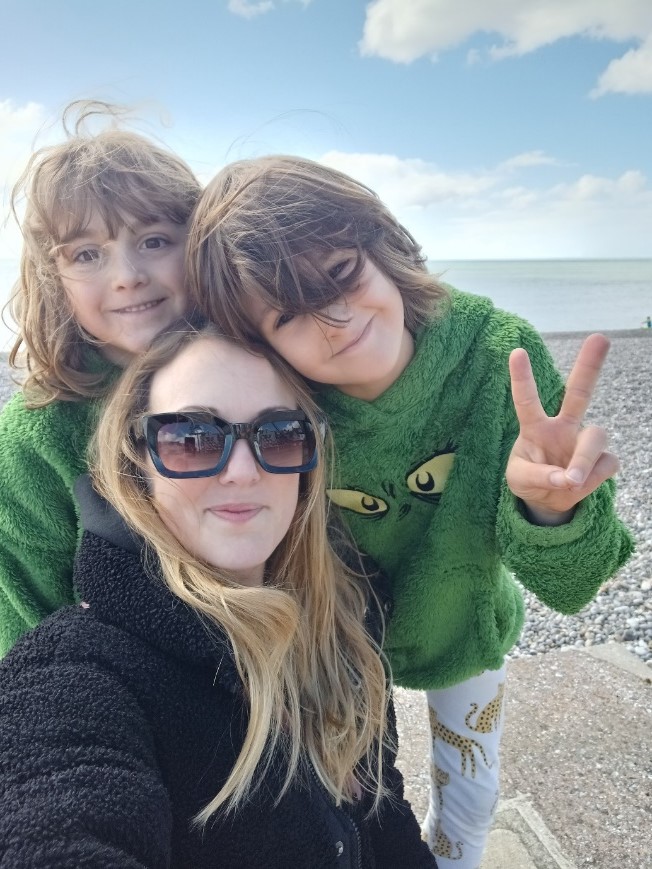
Exploring the Jurassic Coast with my sons.
The past three years have
been a bit of a whirlwind. As a single parent, during lockdown I became a
full-time home educator to my two children whilst trying to keep on top
of all my academic studies, then my eldest broke his arm, staff strikes
at university and school meant I couldn’t attend classes, I was stuck
dealing with a messy divorce, had to move house, and finally just to top
it all off, there was a marking boycott so that I wasn’t sure I would
graduate at all!
Archaeology is a passion I want to share with others through outreach.
Whilst completing my BA I undertook a lot of volunteering work which
sought to bring archaeology to local communities within the university,
local schools and the wider public in and around Bristol, and for which I
was awarded the Everyday Hero - Outstanding PLUS Award by the
University.
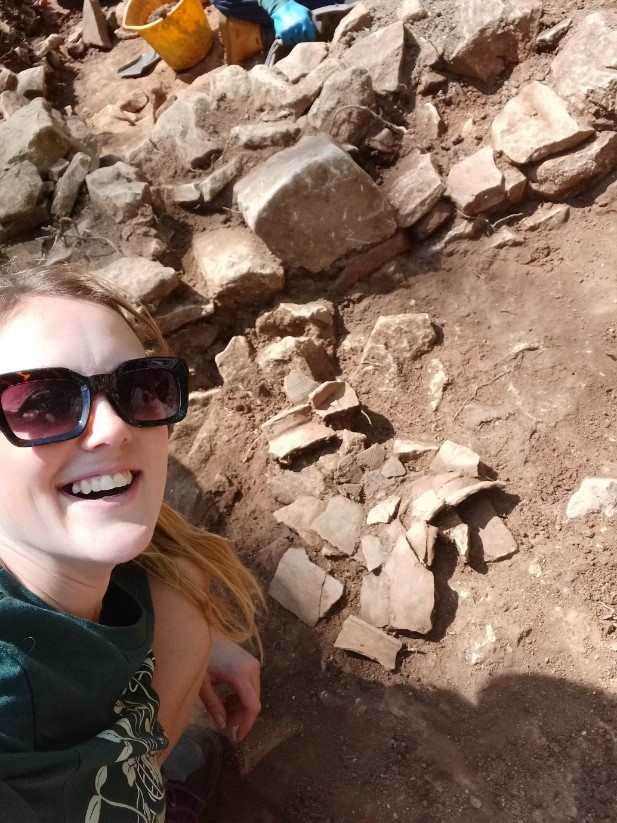
Excavating medieval pottery earlier this year.
During the university archaeological excavations at Lower Hazel (as featured in BBC’s Digging for Britain)
as part of the South-West Anarchy Research Project led by Dr Stuart
Prior, I volunteered to teach specialist archaeobotanical processing
skills to other students to learn about the use of plants in the past.
For this work, I was awarded a Faculty Commendation for Academic
Citizenship. My dissertation examined the botanical remains from these
excavations and this research is being published as part of the 2022
report. I have continued to volunteer on this project and am currently
processing soil samples taken during this year’s excavations to further
our knowledge of the site. As a child I was taught by my grandmother and
mother to appreciate wild plants and to look after our planet. This is a
lesson I have carried into adulthood and which I am passing on to my
children. I love the idea of combining my passions for the natural world
and for archaeology in order to reconstruct past environments. I hope
to continue my studies at the University of Bristol with an MPhil
researching botanical remains from the fort at Vindolanda, on Hadrian’s
Wall.
Outside university life I am an avid lover of Lindy hop dancing, enjoy
taking long walks in nature, climbing mountains, or trees, or castle
ruins, reading, animal rights activism and baking prize winning vegan
cakes.
I am really excited to be part of UBSS and look forward to meeting other
members during caving expeditions (and I know my sons will love to get a
chance for some real adventures too!).
You can find me on Linked in! I'm always keen to make new connections.
Charlotte Harman
Museum Curator, Linda Wilson, takes up the tale...
We still have a lot of work to be done before the Stables can fully
reopen, but hopefully we can at least have the rooms themselves ready
for opening when the new terms starts, although it will take a lot
longer than that to complete the reorganisation of the library stack
room and the redisplay of the museum. So if you're around Bristol over
August and September, please join our working days. These will be
advertised on social media and by email when we have some dates fixed.
Charlotte and I are meeting regularly and will also be meeting Kate Iles
from Bristol City Museum, who has kindly agreed to ake on the role of
our museum mentor for the accreditation progress and Alex Gibson of
South West Museum Development who will be providing additional guidance.
We're also grateful for the help from within the university,
particularly from colleagues within the Theatre Collection.
The first thing we have to do is draft a Forward Plan, and within this
we need to consider what resources (both people and financial) we have
to meet our objectives, and of course, we have to decide what our
objectives are! Charlotte and I will be working together on this, which
will go to the committee for approval. A primary objective will be to
maintain the museum's excellent research record and establish greater
outreach both to our own members and the local community. A Forward Plan
is the first step on the ladder known as working towards accreditation.
We hope to accomplish this within August.
We'll keep everyone informed of how things progress, so watch this space!
Linda Wilson
|
|
LIBRARY AMNESTY

Not the UBSS library.
Do you have any UBSS library books? Our naked shelves need covering! Librarian Nathan Cubitt promises no fines for anyone returning books...
As you are probably aware, the last few years have been a testing time
for the museum and library, with the stairs condemned and replaced, then
the replacement of the gas fires by electric heating followed by urgent
repair work needed on the fabric of the building.
Now however we are in the process of putting everything back in place.
This includes moving the library bookshelves back in the stack room
upstairs and putting miles of books and journals back on to them,
hopefully in time for the new academic year.
This now gives us the ideal opportunity to log and computerize our
collection, so this is the perfect time to check if you have borrowed
any of our books, maybe even on what now seems like a semi-permanent
basis, and let us know! Honestly, we won't judge.
This will allow us to identify missing tomes, and to consider replacing them.
If you still require the books for research, that is absolutely fine.
However we'd still like to know what you have so we can organise the
shelving accordingly.
Nathan Cubitt
|
|
AMAZING CAVE, GROMIT!
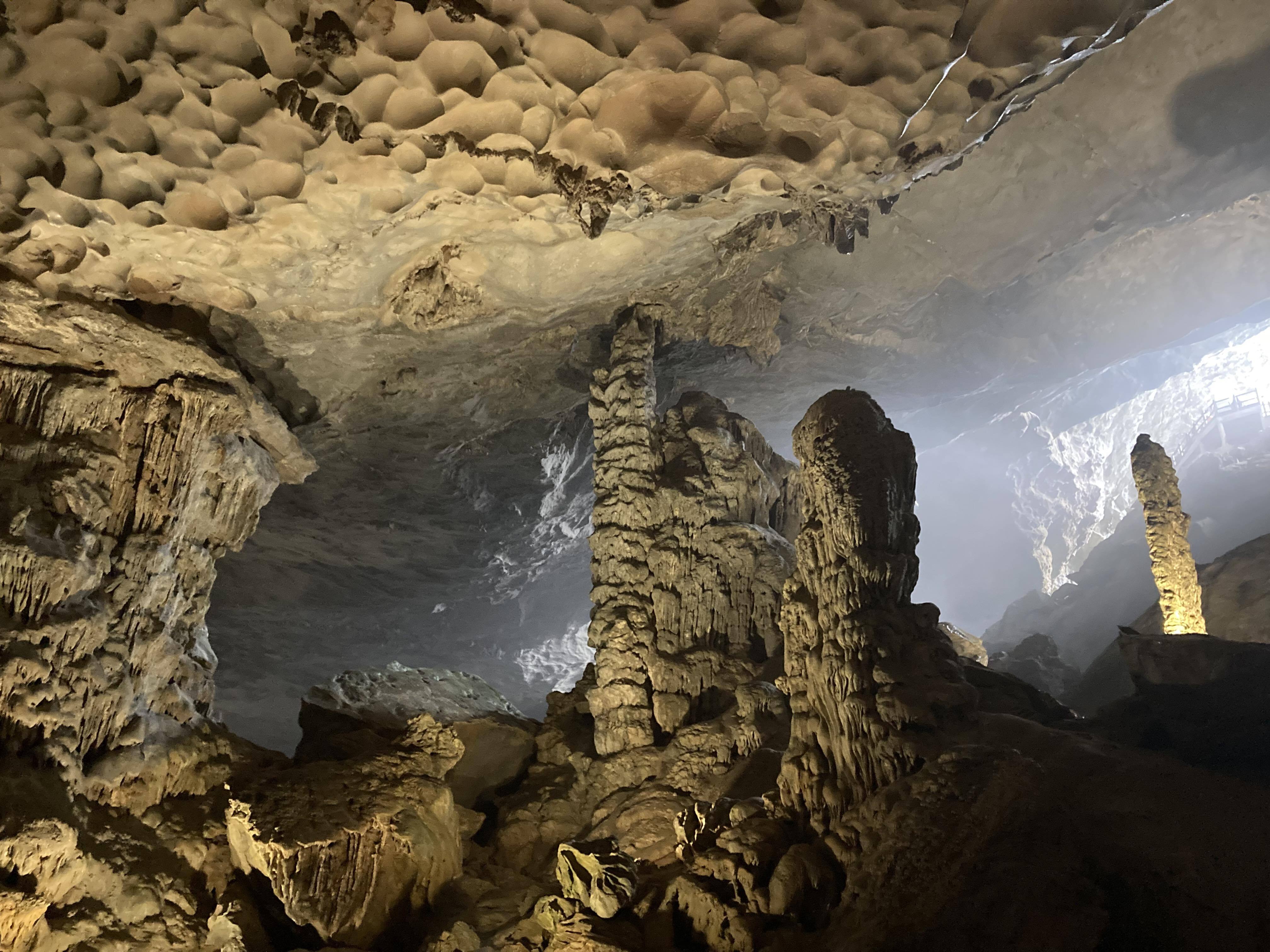
On a recent visit to Northeastern Vietnam, Elliott McCall visited Hạ
Long Bay showcave, engaging in some strenuous queuing, showing how hard
our foreign correspondents have to work just so we can gawk at the
world from our armchairs.

A boat ride through the beautiful Hạ Long Bay, takes passengers to a crowded landing area with wooden steps leading up the side of a cliff.
According to legend, the bay was formed as a protection against invaders
when a mother dragon and her children spat jewels and jade to form a
barrier (the islands) and then decided to stay in the area, giving it
its name Hạ Long, descending dragon.
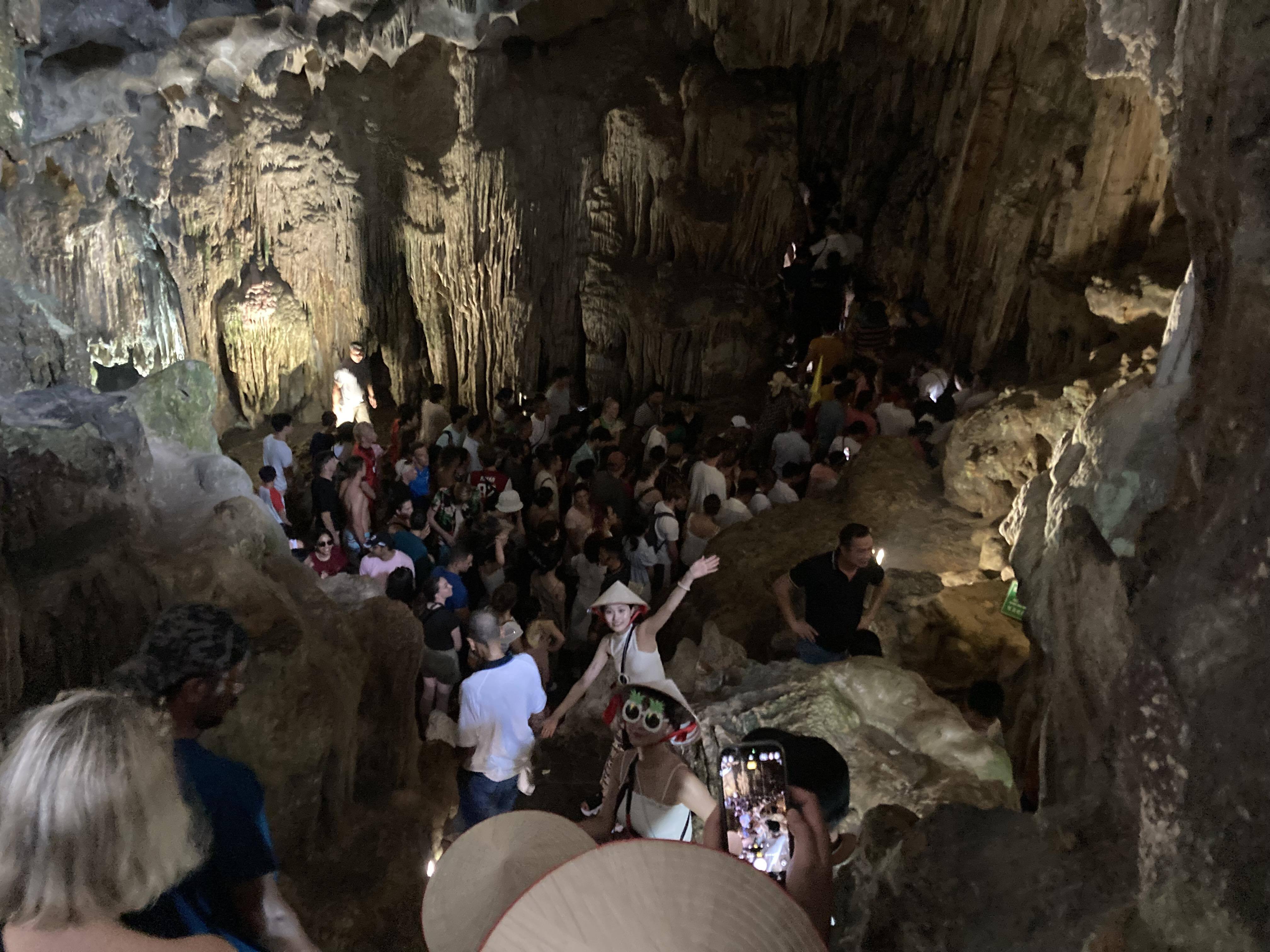
Slowly making your way one very slow step at a time, jostling for
position in the crowd, the entrance is reached. Here the most comical
example of cave congestion is witnessed as it takes 20 minutes standing
in the entrance chamber to clear the traffic jam. At least here shade is
provided from the heat  . .
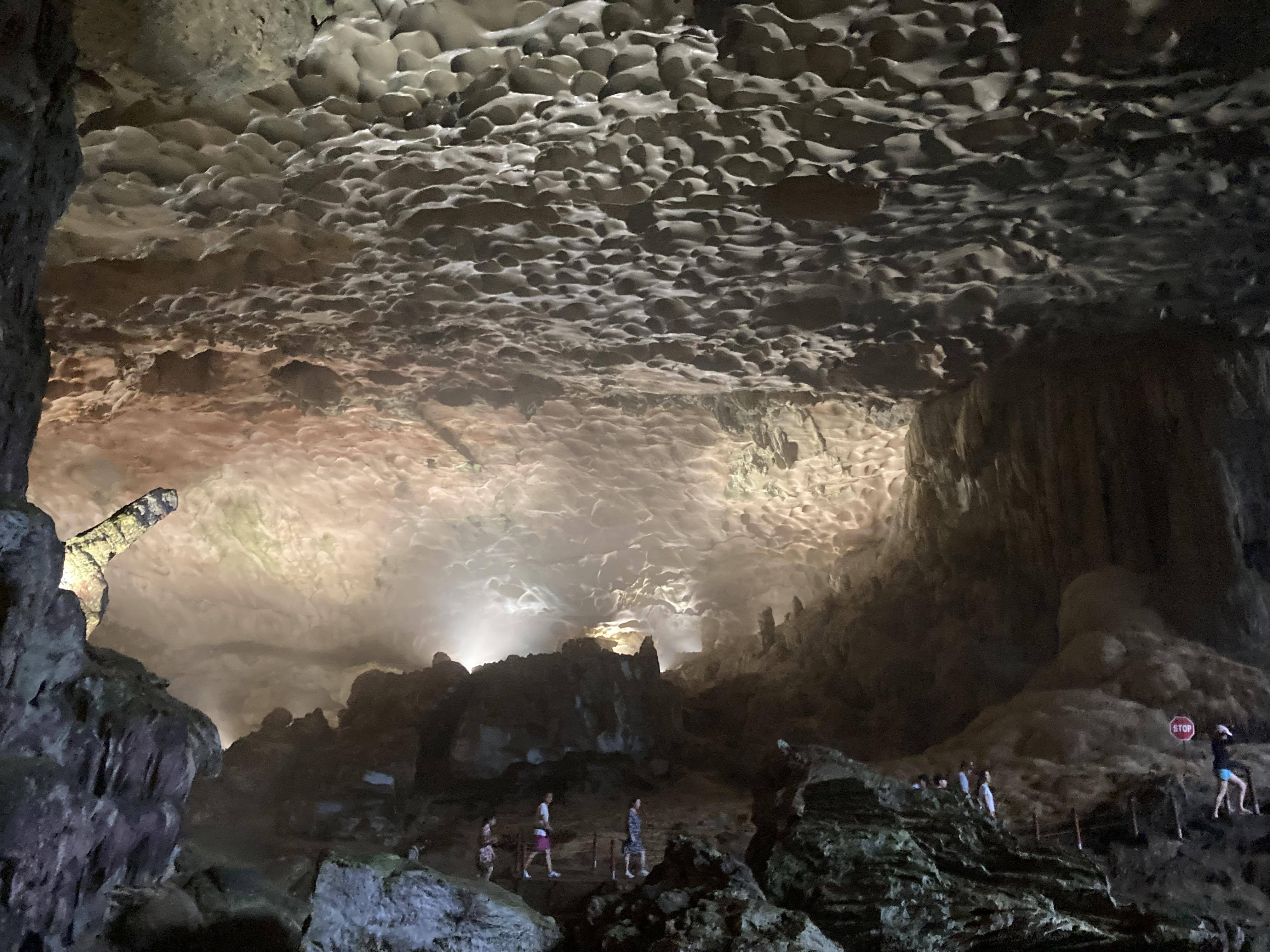
Even more comical than the queue is the tourists pretending not to notice the giant cock and balls in the room..
The
actual name of the cave is sometimes translated as Surprise Cave or
Amazing Cave as the French colonists were said to have exclaimed
something along those lines upon ‘discovering’ it. After a short climb
(up some steps) with lots of protection (a metal handrail) the main
chamber is reached. Here, openings on one side allow light in.
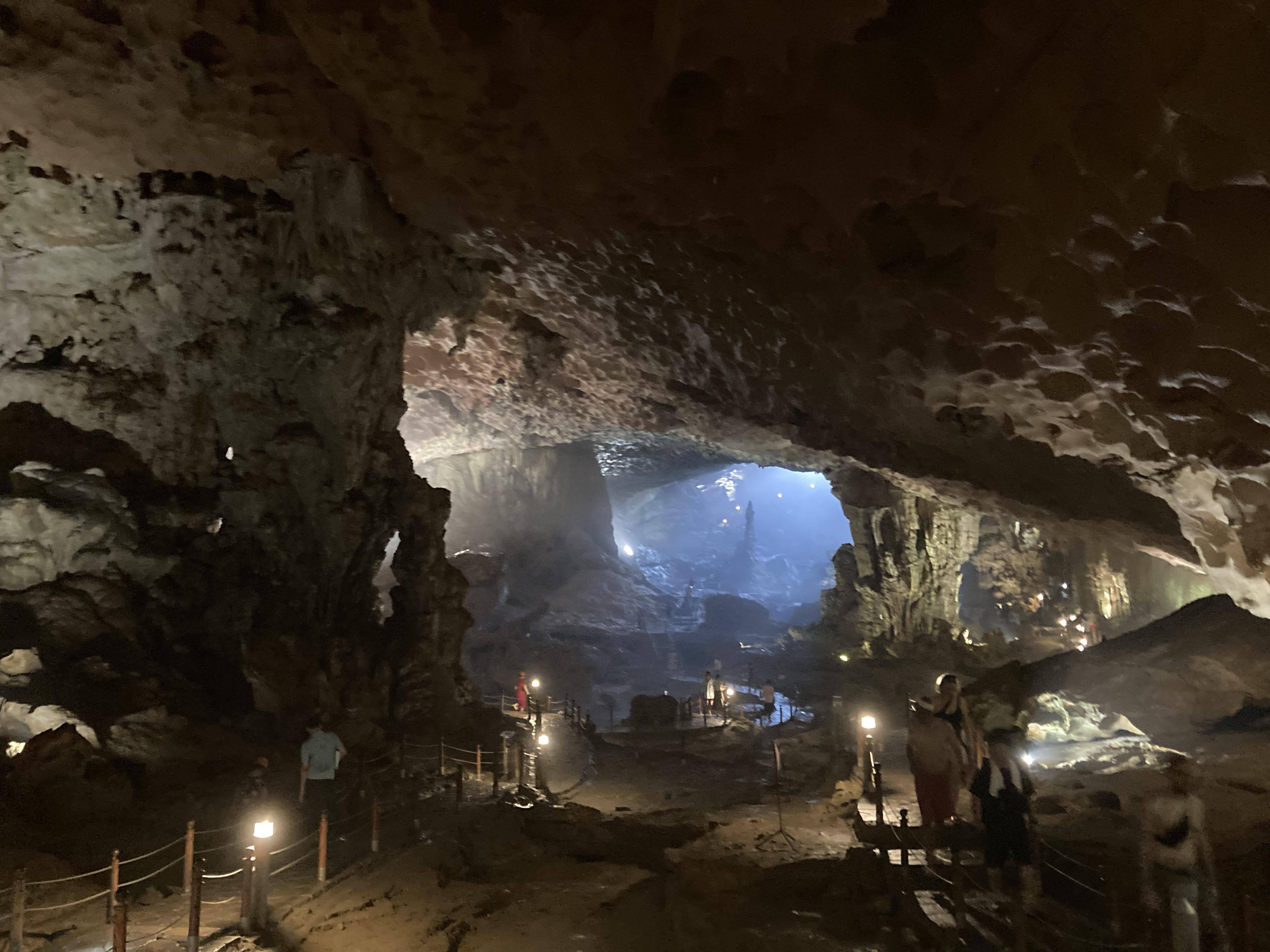
There's lots of pretty stal in this really quite huge chamber and
mercifully the traffic is left behind from the entrance. A short walk
around here leads to the exit. Overall this is a lovely show cave!
Elliott McCall
|
|
HELP NEEDED!
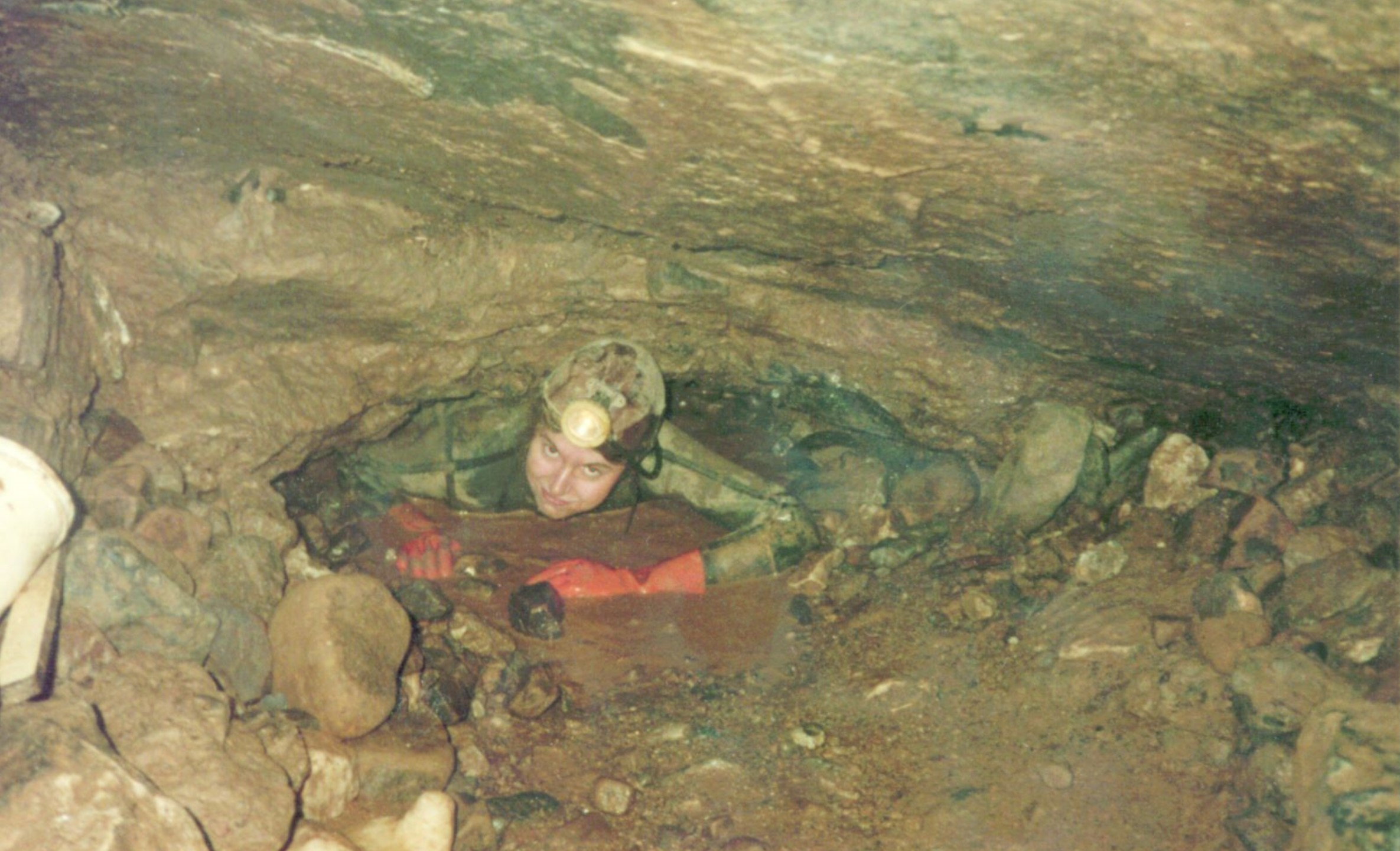
Linda Wilson emerging from the grovel at
the end of Ladder Dig sometime in the '80s, in the days when she still
owned a wetsuit. She still has that ever so nice little brown helmet but
only wears it on ceremonial occasions. Photographer unknown.
Calling any UBSS members involved in the Ladder Dig extensions in GB ...
I have been talking to a caver who has been filming in GB. His name is
Mike Perryman and some of you with long enough memories may recall
caving with him in Ireland in the late 1970s.
Mike has completed his underground filming and aims to submit the finished product to the Kendal Film Festival later this year.
He was saying to me, “If there could be one or two (or even more) UBSS
people who were involved in the early Ladder Dig/Great
Chamber/Disappointment Chamber discoveries (mid-1960s?), and willing to
be interviewed, some personal recollections could be a really excellent
complement to the film.“
So if there are any of you ought there who not only recall those events but are willing to talk about them on camera, please drop me a line.
Graham Mullan
|
|
SMAUGLET REALLY HOPES YOU'VE MADE IT THIS FAR ...

Image created by Bing AI.
Go on, make a little dragon very happy and
drop them a line to let them know you've made it to the end! We'd like
to thank all the lovely people who do let us know you're reading! It's a
simple as clicking the link below. You don't even have to say nice
things to us ... actually, yes you do. We're sensitive souls.
- A splendid newsletter, as always, and wonderfully well
delivered. Please tell the Reluctant Caver that in Cornwall things
similar to a thermic lance have, indeed, been used to access old mines. I
believe the colloquial term is a gas axe. And no I don’t recommend it
as a technique in general or accessing this mine in particular.
[Graham Mullan]
- Delightful newsletter, as always. I loved the diverse
gettings-up-to this month. So many different activities, so much fun,
and the photos are really superb. [Jan Walker]
- A great worm newsletter as ever! [Eve Gilmore]
- Splendid work, dear editors and writers and photographers. And a
little train for added value! I have added Hidden Realms to my list of
books to search out, given I’m a sucker for stunning pix. [Sharon
Wheeler and the blessed FT Bear]
- Great newsletter, especially the article from the Reluctant
Caver. And taking inspiration from Postojna, the idea of installing a
railway in Ogof Draenen to negate those boulders is very
appealing... {Andy Farrant]
- Great photos and content as usual, although I can’t believe how
naïve some senior cavers are who should know better and still believe it
when they are told, come caving “you will enjoy it". [Steve
Hobbs]
- Currently reading this from the potato hut at base-camp on the
CUCC Austria expedition. Found the Cornwall stuff fascinating! Need to
hear more from the Reluctant Caver! [Zac Woodford]
Of course I've read to the end, Smauglet, darling!
THE END
|
|
|
|